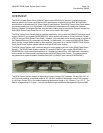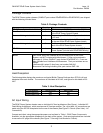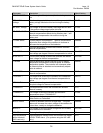
PANDUIT DPoE Power System User’s Guide Issue 1.0
Part Number: PN380
DC Output
DC connections are accomplished via the rear terminal blocks and bulk output connection as shown in
Figure 9: Chassis (Rear View) - DC Connections. GMT-fused connections are accomplished via the rear
compression screw terminal block that will accept wires sizes up to 12 AWG. Place wire in output and
corresponding return, and compress the screws to 4 in-lbs. Place a fuse into the corresponding position
into the fuse holder as shown in Figure 8: Chassis (Front View) - GMT fuse holder.
The DPoE Power System Chassis allows a bulk DC connection as shown in Figure 9: Chassis (Rear
View) - DC Connections. The bulk DC connection may be optionally used to ensure continued power to
the connected DPoE Power Patch Panels and the PD connected to the panels in the event of a power
failure. This connection may be used as a battery input or as an unfused bulk output. The bulk DC
connection requires properly crimped terminal lugs (1/4” single hole lug with a max tongue width of 0.63”
or less). Terminal lugs (such as PANDUIT part number LCA4-14-L for use with #3 or #4 AWG stranded
wire or #2 AWG solid wire) and crimping tools (such as the PANDUIT part numbers CT-1550, CT-1551,
CT-1570, or CT-1700) are available from PANDUIT Corp. The bulk output terminals feature a break-off
plastic piece to prevent inadvertent contact with the terminals. If using the bulk DC output feature,
carefully break off each plastic tab before securing the terminal lugs.
Size wires based on the total rectifier capacity and choose conductor size according to Table 5: Minimum
Recommended DC AWG for 90° C Cabling for Unprotected Outputs . For battery or bulk DC
connections, place lug on the corresponding positive and negative studs, and secure the connections with
the included nuts.
Slot 1
Slot 14
SLOT
for NIC
Card
Figure 8: Chassis (Front View) - GMT fuse holder
GMT fused return
output connections
Positive Output
or Battery Input
GMT fused negative
output connections
Negative Output
or Battery Input
Figure 9: Chassis (Rear View) - DC Connections
10


















